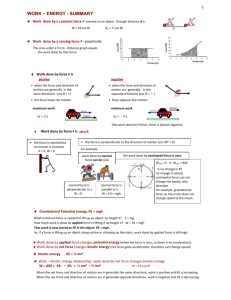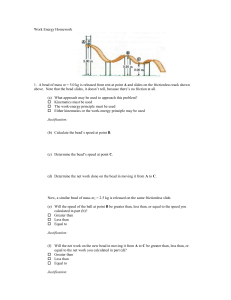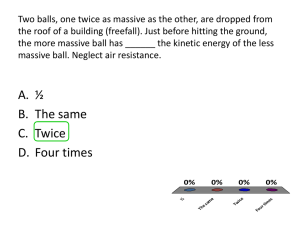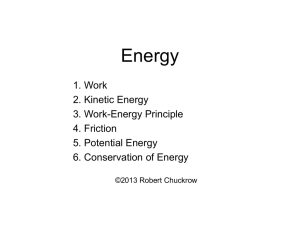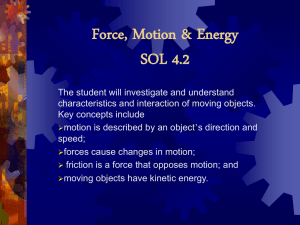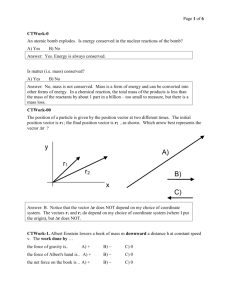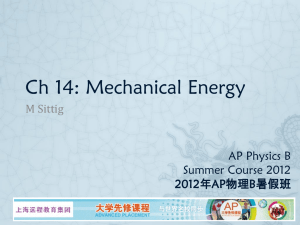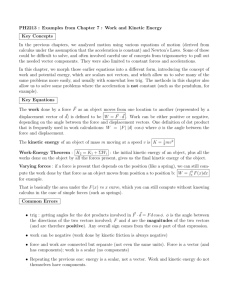Recitation ch7
advertisement
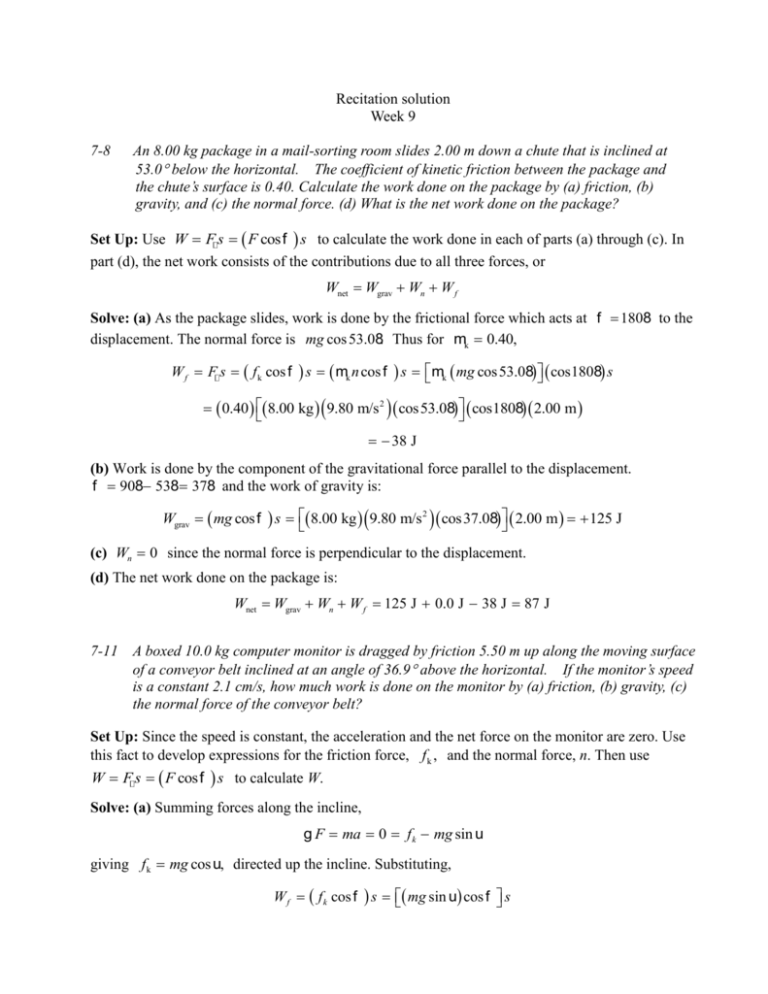
Recitation solution Week 9 7-8 An 8.00 kg package in a mail-sorting room slides 2.00 m down a chute that is inclined at 53.0 below the horizontal. The coefficient of kinetic friction between the package and the chute’s surface is 0.40. Calculate the work done on the package by (a) friction, (b) gravity, and (c) the normal force. (d) What is the net work done on the package? Set Up: Use W F s F cos f s to calculate the work done in each of parts (a) through (c). In part (d), the net work consists of the contributions due to all three forces, or Wnet Wgrav Wn W f Solve: (a) As the package slides, work is done by the frictional force which acts at f 1808 to the displacement. The normal force is mg cos 53.08. Thus for mk 0.40, W f F s f k cos f s mk n cos f s mk mg cos 53.08 cos1808 s 0.40 8.00 kg 9.80 m/s 2 cos53.08 cos1808 2.00 m 38 J (b) Work is done by the component of the gravitational force parallel to the displacement. f 908 538 378 and the work of gravity is: Wgrav mg cos f s 8.00 kg 9.80 m/s 2 cos37.08 2.00 m 125 J (c) Wn 0 since the normal force is perpendicular to the displacement. (d) The net work done on the package is: Wnet Wgrav Wn W f 125 J 0.0 J 38 J 87 J 7-11 A boxed 10.0 kg computer monitor is dragged by friction 5.50 m up along the moving surface of a conveyor belt inclined at an angle of 36.9 above the horizontal. If the monitor’s speed is a constant 2.1 cm/s, how much work is done on the monitor by (a) friction, (b) gravity, (c) the normal force of the conveyor belt? Set Up: Since the speed is constant, the acceleration and the net force on the monitor are zero. Use this fact to develop expressions for the friction force, f k , and the normal force, n. Then use W F s F cos f s to calculate W. Solve: (a) Summing forces along the incline, g F ma 0 f k mg sin u giving f k mg cos u, directed up the incline. Substituting, W f f k cos f s mg sin u cos f s 10.0 kg 9.80 m/s 2 sin 36.98 cos 08 5.50 m 324 J (b) The gravity force is downward and the displacement is directed up the incline so f 126.98. Wgrav 10.0 kg 9.80 m/s 2 cos126.98 5.50 m 324 J (c) The normal force, n, is perpendicular to the displacement and thus does zero work. Reflect: Friction does positive work and gravity does negative work. The net work done is zero. 7-14 Adult cheetahs, the fastest of the great cats, have a mass of 70 kg and have been clocked at 72 mph (32 m/s). (a) How many joules of kinetic energy does such a swift cheetah have? (b) By what factor would its kinetic energy change if its speed were doubled? Set Up: Use K 12 my 2 to relate y and K. Solve: (a) K 1 2 70 kg 32 m/s 2 3.6 3 104 J (b) K is proportional to y 2 , so K increases by a factor of 4 when y doubles. 7-19 The driver of an 1800 kg car (including passengers) traveling at 23.0 m slam on the brakes, locking the wheels on the dry pavement. The coefficient of kinetic friction is typically 0.70. (a) Use the work-energy principle to calculate how far the car will travel before stop. (b) How far would the car travel if it were going twice as fast? (c) What happened to the car’s original kinetic energy? 7.19. Set Up: Use the work-kinetic energy theorem: Wnet Kf Ki Fnet s. Since the net force is due to friction, Fnet s f k s mk mgs. Also, since the car stops, Kf 0. Solve: (a) Wnet Kf Ki Fnet s gives 12 my i 2 mk mgs. Solving for the distance, 23.0 m/s y2 s i 38.6 m 2mk g 2 0.700 9.80 m/s 2 2 (b) Since s is proportional to y i 2 , doubling y i increases s by a factor of 4; s therefore becomes 154 m. (c) The original kinetic energy was converted into thermal energy by the negative work of friction. Reflect: To stop the car friction must do negative work equal in magnitude to the initial kinetic energy of the car. 7-21 You throw a 20 N rock into the air from ground level and observe that, when it is 15.0 m high, it is traveling upward at 25 m/s. Use the work-energy principle to find (a) the rock’s speed just as it left the ground and (b) the maximum height the rock will reach. Set Up: From the work-energy relation, W Wgrav DK rock or F s K f Ki . As the rock rises, the gravitational force, F mg , does work on the rock. Since this force acts in the direction opposite to the motion and displacement, s, the work is negative. Solve: (a) Applying F s K f K i we obtain: mgh 12 my f 2 12 my i 2 Dividing by m and solving for y i , yi y f 2 2 gh. Substituting h 15.0 m and y f 25.0 m/s, yi 25.0 m/s 2 2 9.80 m/s 2 15.0 m 30.3 m/s (b) Solve the same work-energy relation for h. At the maximum height y f 0. mgh 12 my f 2 12 my i 2 y 2 y f 2 30.3 m/s 0.0 m/s h i 46.8 m 2g 2 9.80 m/s 2 2 2 Reflect: Note that the weight of 20 N was never used in the calculations because both gravitational potential and kinetic energy are proportional to mass, m. Thus any object, that attains 25.0 m/s at a height of 15.0 m, must have an initial velocity of 30.3 m/s. As the rock moves upward gravity does negative work and this reduces the kinetic energy of the rock. 7-23 A 61 kg skier on level snow coasts 184 to a stop from a speed of 12.0 m/s. (a) Use the work-energy principle to find the coefficient of kinetic friction between the skis and the snow. (b) suppose a 75 kg skier with twice the starting speed coasted the same distance before stopping. Find the coefficient of kinetic friction between the skier’s skis and the snow. Set Up: Use Wnet W f f k s mk mgs and Wnet Kf Ki . The skier stops, so Kf 0. Solve: (a) Setting the two expression for net work equal, Wnet mk mgs 12 my i 2 . Solving for the coefficient of kinetic friction, 12.0 m/s yi2 mk 3.99 3 102 2 2 gs 2 9.80 m/s 184 m 2 (b) The mass m of the skier divides out and mk is independent of m. If y i is doubled while s is constant then mk increases by a factor of 4; mk 0.160. Reflect: To stop the skier friction does negative work that is equal in magnitude to the initial kinetic energy of the skier.

